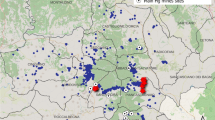Summary
In order to assess the degree of thallium exposure in a population living around a thallium emitting cement plant in a small city in North-West Germany thallium levels in 24 h urine samples of 1,265 subjects and in hair samples of 1,163 subjects were determined. Urinary thallium levels in two groups of subjects living in an urban and a rural area of West Germany were determined for reference. As compared to these subjects the population living around the cement plant exhibited obvious signs of increased thallium intake. The mean urinary thallium concentration was 2.6 μg/1 and ranged up to 76.5 pg/1. In contrast, the mean urinary thallium levels of the two reference groups were 0.2 and 0.4 μg/1, respectively. Hair thallium levels of the population living around the cement plant were also markedly increased (mean: 9.5 ng/g). The major route of the population's increased intake of thallium was found to be the consumption of vegetables and fruit grown in private gardens in the vicinity of the cement plant. As was shown by chemical analyses vegetables and fruit grown in these gardens were contaminated by thallium-containing atmospheric dust fall-out caused by emissions of the cement plant. The pulmonary route of uptake as well as other sources did not seem to play a significant role in the population's exposure to thallium. Polyneuritic symptoms, sleep disorders, headache, fatigue and other signs of psychasthenia were found to be the major health effects associated with increased thallium levels in urine and hair. No positive correlation was found between the thallium levels in hair and urine and the prevalence of skin alterations, hair-loss and gastro-intestinal dysfunctions.
Similar content being viewed by others
References
Brockhaus A, Dolgner R, Ewers U, Wiegand H, Freier I, Jerman E, Krämer U (1980) Excessive thallium absorption among a population living near a thallium emitting cement plant. In: Holmstedt B, Lauwerys R, Mercier M, Robberfroid M (eds) Mechanisms of toxicity and hazard evaluation (Proceedings of the Second International Congress on Toxicology, Brussels 1980) Elsevier/North Holland, Amsterdam New York Oxford ((Development on Toxicology and Environmental Science, vol 8, pp 565–568)
Buchet JP, Roels H, Lauwerys R, Bruaux P, Claeys-Thoreau F, Lafontaine A, Verduyn G (1980) Repeated surveillance of exposure to cadmium, manganese, and arsenic in school-age children living in rural, urban, and nonferrous smelter areas in Belgium. Environ Res 22:95–109
Franke JP, Coenegracht PMJ, de Zeeuw RA (1975) A rapid and specific method for the determination of traces of thallium directly in urine by differential pulse anodic stripping voltametry. Arch Toxicol 34:137–143
Geilmann W, Beyermann K, Neeb KH, Neeb R (1960) Thallium, ein regelmäßig vorkommendes Spurenelement im tierischen und pflanzlichen Organismus. Biochem Zeitschr 333:62–70
Glomme J (1972) Encyclopedia of occupational heath and safety, vol 11. International Labour Office (ILO), Geneva
Goenechea S, Sellier K (1967) Über den natürlichen Thalliumgehalt des menschlichen Körpers. Dtsch Z Ges Gerichtl Med 60:135–141
Hagedorn-Götz H, Stoeppler M (1975) Zum forensischen Nachweis von Thallium in menschlichen Haaren durch flammenlose Atomabsorptionsspektrometrie. Arch Toxicol 34:17–26
Henke G, Bohn G (1969) Zum Nachweis einer zweimaligen Thalliumvergiftung durch aktivierungsanalytische Untersuchung von Haaren und Nägeln. Arch Toxicol 25:48–56
Henke G, Fitzek A (1971) Nachweis von Thalliumvergiftungen durch Neutronenaktivierungsanalyse. Arch Toxicol 27:266–272
Kazantzis G (1979) Thallium. In: Friberg L, Nordberg GF, Vouk V (eds) Handbook on the toxicology of metals. Elsevier, Amsterdam, pp 599–612
Kemper FH (1979) Thallium-Vergiftung. Münch Med Wochenschr 121:1357–1358
Ministerium fur Arbeit, Gesundheit und Soziales und Ministerium für Erndhrung, Landwirtschaft und Forsten des Landes NW (Nordrhein-Westfalen) (1980) Umweltbelastung durch Thallium; Untersuchungen in der Umgebung der Dyckerhoff-Zementwerke AG in Lengerich sowie anderer Thalliumemittenten im Lande NW. Düsseldorf
Mühlendahl KE, Etzold R, Krienke EG (1978) Thalliumvergiftungen im Kindesalter. Dtsch Med Wschr 103:1116–1117
Prinz B, Krause GHM, Stratmann H (1979) Thalliumschäden in der Umgebung der DyckerhoffZementwerke AG in Lengerich, Westfalen. Staub-Reinhalt Luft 39:457–462
Roels HA, Buchet JP, Lauwerys RR, Bruaux P, Claeys-Thoreau F, Lafontaine A, Verduyn G (1980) Exposure to lead by the oral and the pulmonary routes of children living in the vicinity of a primary lead smelter. Environ Res 22:81–94
Sayre JW, Charney E, Vostal J, Pless IB (1974) House and hand dust as a potential source of childhood lead exposure. Amer J Dis Child 127:167–170
Schaller KH, Manke G, Raithel HJ, Bühlmeyer G, Schmidt M, Valentin H (1980) Investigations of thallium exposed workers in cement factories. Int Arch Occup Environ Health 47:223–231
Smith IC, Carson BL (1977) Trace metals in the environment, vol 1, Thallium. Ann Arbor Science Ann Arbor
Stokinger HE (1967) Thallium. In: Patty FA (ed) Industrial hygiene and toxicology, vol 3. Wiley, New York, pp 1138–1145
Valentin H, Lehnert G, Petry H, Weber G, Wittgens H, Woitowitz HJ (1979) Arbeitsmedizin, Bd 2. Thieme, Stuttgart, S 28
Weinig E, Zink P (1967) Über die quantitative massenspektrometrische Bestimmung des normalen Thalliumgehaltes im menschlichen Organismus. Arch Toxicol 22:255–274
Author information
Authors and Affiliations
Rights and permissions
About this article
Cite this article
Brockhaus, A., Dolgner, R., Ewers, U. et al. Intake and health effects of thallium among a population living in the vicinity of a cement plant emitting thallium containing dust. Int. Arch Occup Environ Heath 48, 375–389 (1981). https://doi.org/10.1007/BF00378686
Received:
Accepted:
Issue Date:
DOI: https://doi.org/10.1007/BF00378686



